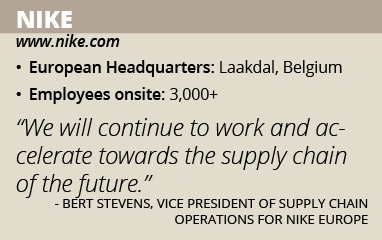Nike
Nike’s expanded European Logistics Campus makes its operations more efficient and sustainable, enabling growth. By Stephanie Crets
Although most consumers know Nike from its trademark logo and innovative sportswear and equipment, many might not be aware that the company is on the forefront of sustainable manufacturing and supply chain operations. It has always incorporated sustainable solutions into its facilities, but the newly expanded Nike European Logistics Campus in Belgium takes those efforts to another level.
“We are working towards the supply chain of the future,” says Bert Stevens, vice president of supply chain operations for Nike Europe. “Our campus in Europe is a prime example of how you can combine high performance and sustainability at the same time.”
The expanded facility will not only make Nike’s overall operations more efficient, but it will enable growth by serving its customers across retail and wholesale channels from one inventory location. Globally, Nike ships more than one billion items of apparel and equipment annually, so it must adapt to the customer demand and tremendous growth.
“We need to stay flexible and scalable with our distribution centers,” Stevens says. “We have been significantly growing in the past years. When we completed the new expansion, it was already too small. So, we are already building an expansion to the expanded campus at this moment.”

Renewable Energy Focus
The expanded Nike campus houses more than 3,000 employees and operates using 100 percent renewable energy. It sources its energy from five locally generated sources: wind, solar, geothermal, hydroelectric and biomass. Six 492-foot-high wind turbines onsite produce enough electricity to power 5,000 homes, while onsite solar panels cover the size of three soccer fields. In addition, pathways on the campus are created from recycled footwear material and more than 95 percent of waste generated onsite is recycled.
“There is a global strategy that was communicated [throughout the company] and we will go for 100 percent renewable electricity in all our owned and operated facilities by 2025,” Stevens explains. “In line with that, we have to ensure our whole supply chain becomes 100 percent renewable. That’s one key pillar in our strategy. We’ve learned along the way that the focus on our footprint is really helping us become more efficient.”
The facility was also designed to support the surrounding landscape through biodiversity. Sheep will help naturally maintain the greenery, while onsite beehives will contribute to biodiversity through the pollination of flowers around the campus. “We scanned the surrounding area to see how many animals and species of plants were there,” Stevens says. “Our aim is that biodiversity is higher after the building is there. We have green roofs and walls. These are all very unique items for a warehouse.”
Thanks to an intricate infrastructure of canals, railways and highways, 99 percent of inbound containers reach the local container park by water, not road, saving 14,000 truck journeys a year. Nike also made sure to design flexibility into its facility for a more efficient supply chain. Its workstations and carts were created from a modular cube system. Workers can reconfigure them into any shape they see fit.
The warehouse also uses hybrid cranes, which regenerate electricity like hybrid cars, to react quickly to demands in the supply chain. Employees can also use man-riders with telescopic arms to fill shipping containers all the way to the top and make the most out of all the space. This reduces fuel emissions with fewer trucks on the road.
“The systems are designed so that we can do everything in efficient ways,” Stevens says. “One of the key things we want to emphasize is we focus on sustainable innovation. We are choosing innovation to create new things that are better for the business and the planet.”
Sports Culture
Nike has little trouble finding employees to join the team. In fact, Stevens says it had 10 times more applicants than jobs available to work on the European campus. He credits this to Nike’s ability to do the right thing for both the company and the environment.
Many of its sustainable efforts benefit employees as well, such as its vibrant, well-lit workspaces surrounded by big windows. The windows use a daylight-capture system that taps into the LED lighting, which reduces electricity costs and the environment impact. And Stevens says it creates a much more productive workplace.
“We find culture extremely important within the facility,” he continues. “It’s a sports culture. Teamwork is extremely important and that’s true across all of our facilities. We feel like we’re competing at the highest levels like many of the athletes we serve. Our employees are reaching for the highest goals. That key goal is to delight our consumer and exceed their expectations. We focus on the consumer and do it in a collaborative, team effort.”
But Nike isn’t content with its current efforts. The company will continue to innovate in the supply chain and work on more sustainable efforts across all of its facilities to better serve customers and the environment. Nike is tapping into what it has learned from its European campus and implementing many of the features into its facilities in China and other locations.
“This facility is high performing, but also extremely efficient and sustainable – I’m very proud of it,” Stevens says. “We did things very early on and realized what is good for the planet is also very good for the business. But we will continue to work on these items in this space. A lot of the technology is evolving quickly and expectations of consumers will continue to rise. We will continue to work and accelerate towards the supply chain of the future.”